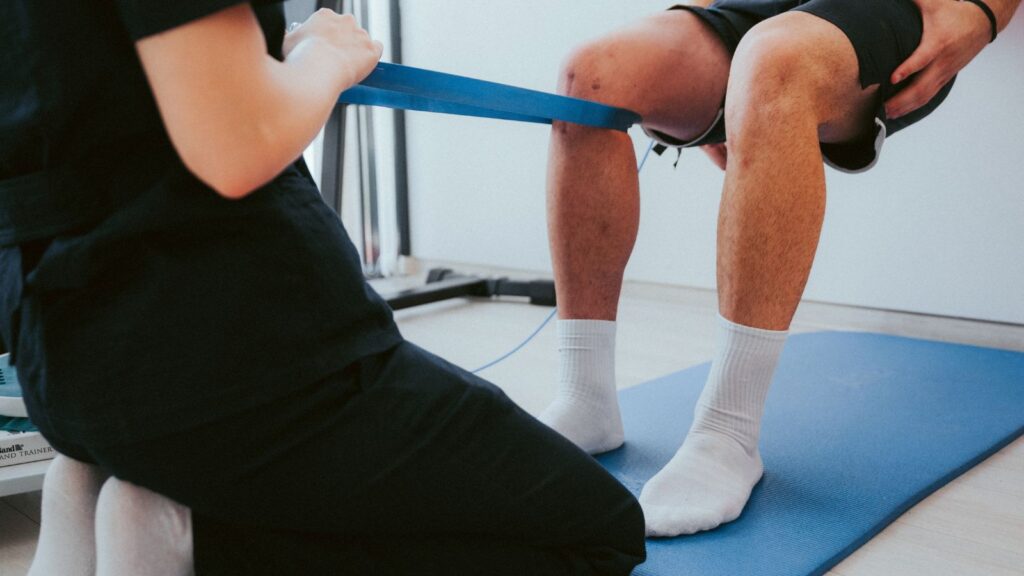Physiotherapy, also known as physical therapy, is a healthcare profession focused on the assessment, diagnosis, treatment, and prevention of physical impairments, disabilities, and pain. Physiotherapists work with people of all ages and backgrounds, from infants to the elderly, and with a wide range of conditions, including musculoskeletal, neurological, respiratory, and cardiovascular disorders. The goal of physiotherapy is to help individuals restore, maintain, and improve their physical function, mobility, and quality of life.
Fundamentals of physiotherapy in Melbourne involve a thorough understanding of human anatomy, physiology, biomechanics, and pathology, as well as the principles and techniques of therapeutic exercise, manual therapy, electrotherapy, and other modalities. Physiotherapists use hands-on techniques and technology to help their patients achieve their goals. They also work closely with other healthcare professionals, such as physicians, nurses, occupational therapists, and speech therapists, to provide comprehensive care.
Physiotherapy techniques vary depending on the type and severity of the condition, as well as the individual’s age, health status, and preferences. Some common methods include stretching, strengthening, mobilization, manipulation, massage, heat and cold therapy, ultrasound, electrical stimulation, and hydrotherapy. Physiotherapists also provide education and advice on proper posture, body mechanics, ergonomics, and lifestyle modifications to prevent further injury or disability.
Key Takeaways
- Physiotherapy is a healthcare profession focused on physical impairments, disabilities, and pain.
- Physiotherapists use a combination of hands-on techniques and technology to help their patients achieve their goals.
- Physiotherapy techniques vary depending on the type and severity of the condition, as well as the individual’s age, health status, and preferences.
Fundamentals of Physiotherapy
History and Evolution
Physiotherapy is a healthcare profession that focuses on preventing, managing, and treating physical impairments, disabilities, and pain. The roots of physiotherapy can be traced back to ancient civilizations, where massage and exercise were used to treat injuries and illnesses. However, it wasn’t until the 19th century that physiotherapy began to evolve into a distinct profession.
In the early 20th century, physiotherapy was primarily used to treat patients with polio and other neurological conditions. Over time, the scope of physiotherapy expanded to include a wide range of conditions, including musculoskeletal, cardiovascular, and respiratory disorders.
Key Principles
The key principles of physiotherapy include the assessment, diagnosis, and treatment of physical impairments and disabilities. Physiotherapists use a range of techniques, including manual therapy, exercise, and electrotherapy, to help patients improve their physical function and reduce pain.
Physiotherapy also emphasizes patient education and self-management. Physiotherapists work closely with patients to develop individualized treatment plans that incorporate exercise and lifestyle modifications to help patients manage their conditions and prevent future injuries.

Scope of Practice
The scope of practice for physiotherapists varies depending on the country and jurisdiction. In general, physiotherapists are trained to assess and treat a wide range of conditions, including musculoskeletal, neurological, cardiovascular, and respiratory disorders.
Physiotherapists may work in a variety of settings, including hospitals, clinics, rehabilitation centers, and private practices. They may also specialize in areas such as sports medicine, pediatrics, or geriatrics.
In conclusion, physiotherapy is a vital healthcare profession that helps patients improve their physical function and quality of life. By focusing on key principles such as assessment, diagnosis, and treatment, physiotherapists are able to provide patients with individualized care that helps them manage their conditions and prevent future injuries.
Physiotherapy Techniques
Manual Therapy
Manual therapy is a hands-on technique used by physiotherapists to assess and treat musculoskeletal pain and dysfunction. It includes various techniques such as joint mobilization, soft tissue mobilization, and manipulation. Joint mobilization involves passive movement of a joint to improve its range of motion. Soft tissue mobilization involves techniques such as massage, myofascial release, and trigger point therapy to release tension in muscles and fascia. Manipulation involves a high-velocity, low-amplitude thrust to a joint to improve its mobility.
Therapeutic Exercise
Therapeutic exercise is a type of physical activity prescribed by physiotherapists to improve strength, flexibility, and endurance. It includes exercises such as stretching, resistance training, and cardiovascular training. Stretching exercises are used to improve flexibility and range of motion. Resistance training involves using weights or resistance bands to improve strength. Cardiovascular training involves activities such as walking, cycling, or swimming to improve endurance.
Electrotherapy
Electrotherapy involves the use of electrical stimulation to promote healing and reduce pain. It includes techniques such as transcutaneous electrical nerve stimulation (TENS), ultrasound, and electrical muscle stimulation (EMS). TENS involves the use of low-voltage electrical current to reduce pain. Ultrasound involves the use of high-frequency sound waves to promote tissue healing. EMS involves the use of electrical current to stimulate muscle contraction and improve strength.
Hydrotherapy
Hydrotherapy involves the use of water to promote healing and reduce pain. It includes techniques such as hot and cold therapy, aquatic exercise, and whirlpool therapy. Hot and cold therapy involves the use of hot or cold water to reduce pain and inflammation. Aquatic exercise involves performing exercises in a pool to reduce stress on joints and improve mobility. Whirlpool therapy involves the use of water jets to massage and promote circulation.
Physiotherapy techniques are an essential part of the rehabilitation process for individuals with musculoskeletal pain and dysfunction. By using a combination of manual therapy, therapeutic exercise, electrotherapy, and hydrotherapy, physiotherapists can help individuals improve their mobility, reduce pain, and improve their overall quality of life.
Specializations in Physiotherapy
Physiotherapy is a diverse field that encompasses various specializations. These specializations are based on the type of conditions that are treated and the techniques used to treat them. Some of the most common specializations in physiotherapy are:
Orthopedic Physiotherapy
Orthopedic physiotherapy deals with the prevention, diagnosis, and treatment of musculoskeletal injuries and disorders. This specialization focuses on improving the function of the musculoskeletal system and reducing pain. Orthopedic physiotherapists use a variety of techniques such as manual therapy, exercise therapy, and electrotherapy to treat conditions such as fractures, sprains, and strains.
Neurological Physiotherapy
Neurological physiotherapy is concerned with the treatment of individuals with neurological disorders such as stroke, Parkinson’s disease, and multiple sclerosis. Neurological physiotherapists work to improve the function of the nervous system and promote independence in daily activities. They use techniques such as gait training, balance training, and functional electrical stimulation to achieve these goals.
Cardiopulmonary Physiotherapy
Cardiopulmonary physiotherapy is focused on the treatment of individuals with cardiovascular and respiratory conditions. This specialization involves the use of exercise therapy, breathing exercises, and airway clearance techniques to improve lung function and cardiovascular health. Cardiopulmonary physiotherapists work with individuals with conditions such as chronic obstructive pulmonary disease (COPD), asthma, and heart failure.
Pediatric Physiotherapy
Pediatric physiotherapy is concerned with the treatment of children with developmental and physical disabilities. Pediatric physiotherapists work to improve the function of the musculoskeletal and nervous systems in children. They use techniques such as play therapy, exercise therapy, and sensory integration to help children achieve their developmental milestones.
Overall, these specializations in physiotherapy demonstrate the breadth and depth of the field. Each specialization requires specific knowledge and skills to treat the conditions effectively. Physiotherapists may choose to specialize in one or more of these areas to provide the best possible care to their patients.
Physiotherapy in Practice
Assessment and Diagnosis
Physiotherapy assessment involves a thorough examination of the patient’s physical condition, medical history, and lifestyle. The physiotherapist evaluates the patient’s posture, strength, flexibility, and range of motion, and identifies any areas of pain or discomfort. Based on the assessment, the physiotherapist formulates a diagnosis and treatment plan tailored to the patient’s individual needs.
Treatment Planning
The treatment plan may include a combination of manual therapy, exercise, and other modalities such as heat, ice, or electrical stimulation. The physiotherapist works with the patient to set achievable goals and tracks progress throughout the course of treatment. Treatment plans are regularly reviewed and modified as necessary to ensure optimal outcomes.
Multidisciplinary Approach
Physiotherapy often involves collaboration with other healthcare professionals such as physicians, occupational therapists, and massage therapists. This multidisciplinary approach ensures that patients receive comprehensive care that addresses all aspects of their physical health.

Patient Education and Self-Management
Patient education is a crucial component of physiotherapy. Physiotherapists teach patients about their condition, how to manage symptoms, and how to prevent future injury. Patients are also taught exercises and techniques they can perform at home to improve their physical function and maintain their progress.
In conclusion, physiotherapy is a valuable healthcare service that helps patients improve their physical function, manage pain, and prevent future injury. Through assessment, treatment planning, a multidisciplinary approach, and patient education, physiotherapists provide comprehensive care that promotes optimal physical health and well-being.
Frequently Asked Questions
What are the Educational Requirements for Becoming a Physiotherapist?
To become a physiotherapist, one must complete a bachelor’s degree in physiotherapy or a related field. In addition, most countries require physiotherapists to pass a licensing exam before they can practice. Some physiotherapists also choose to pursue a master’s degree or PhD in a specialized area of physiotherapy.
How can Physiotherapy Help in Managing Pain?
Physiotherapy can help manage pain by using a variety of techniques such as manual therapy, exercise, and electrotherapy. These techniques can help reduce inflammation, improve mobility, and increase strength, which can all contribute to reducing pain levels.
What Techniques do Physiotherapists Use to Treat Injuries?
Physiotherapists use a variety of techniques to treat injuries, including manual therapy, exercise therapy, electrotherapy, and hydrotherapy. Manual therapy involves hands-on techniques such as massage and joint mobilization, while exercise therapy involves specific exercises to improve strength, flexibility, and range of motion. Electrotherapy involves the use of electrical currents to promote healing, and hydrotherapy involves the use of water to aid in rehabilitation.
What is the Expected Salary Range for a Physiotherapist?
The expected salary range for a physiotherapist varies depending on the country and region they work in, as well as their level of experience and specialization. In general, the salary range for a physiotherapist is competitive with other healthcare professions.
How often Should One Attend Physiotherapy Sessions for Effective Results?
The frequency of physiotherapy sessions depends on the individual and their specific condition. In general, physiotherapy sessions are typically scheduled once or twice a week, but this can vary based on the severity of the injury or condition being treated.
Can Physiotherapy Exercises Be Done at Home, and Are they Effective?
Physiotherapy exercises can often be done at home with guidance from a physiotherapist. These exercises are designed to improve strength, flexibility, and range of motion, and can be effective when done consistently and correctly. However, it is important to consult with a physiotherapist before starting any exercise program to ensure that it is safe and appropriate for the individual’s specific condition.
My name is Andrea Thompson and I’m a home based freelance writer. I’m 23 years old, married to my best friend, and mother to a wonderfully independent and opinionated 3 year old girl and step-mother to a sweet seven year old boy. I live in a tiny, little town in Kentucky, where I spend my free time fishing with my kids.
Writing has always been my passion, which I followed through high school, and for a while in college. Life happened, and once I discovered we were pregnant, I switched directions; opting for the healthcare industry because of the stability.
Finally, years later, I was in a place where I could leave the day job that never truly made me happy, and pursue my dreams. I’ve built, and am still building, my writing career from scratch. But, I’m passionate and I’m good at what I do. And, in the end, I can prove to my daughter that she can do anything she wants with this life.





